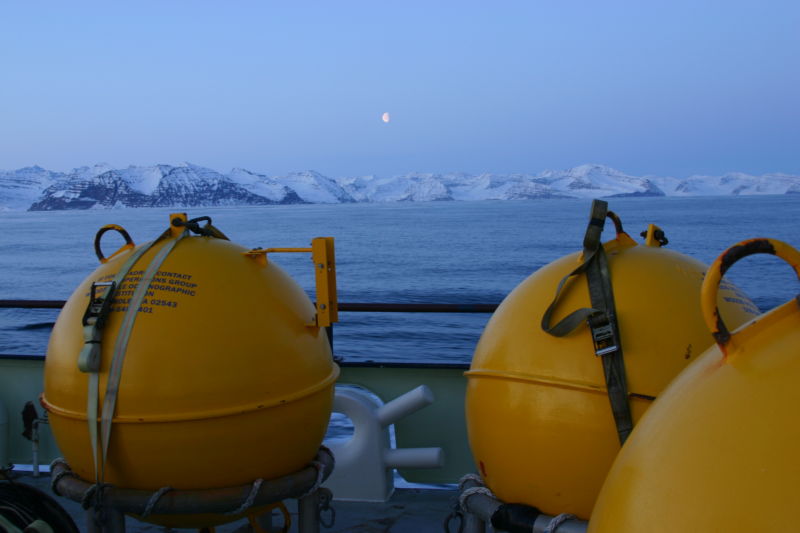
All of the world’s oceans have a similar pattern of currents. Surface waters warm near the equator, then flow toward the poles, where they cool and sink. The cold, dense bottom water makes its way back to restart the cycle. This pattern has particular significance in the North Atlantic, where the flow of warm surface water helps moderate the climate of Northern Europe, parts of which might otherwise resemble Greenland.
A lot of people have pondered whether the warming induced by climate change could interfere with this conveyor belt, preventing the water that nears the Arctic from cooling and sinking. Most analyses, however, suggest that this could only happen after the world had warmed enough that Europe wouldn’t need the currents to moderate its temperature.
A new study, however, suggests that there’s a tipping point for the Atlantic conveyor that could be reached much sooner. It only relies indirectly on warm temperatures; instead, it is driven by the melting of the Greenland Icecap. And the new research suggests we’ve already gone nearly halfway to the tipping point.
Warm or salty
The key issue in all of this is the density of water, which drives the cycling of the oceans. Given similar temperatures, salt water is more dense; given similar salt content, cold water will be more dense. These density differences are large enough that if you have a patch of warm, fresh water sitting on top of cold, salty water, the two bodies won’t mix very efficiently. The water ends up layered, or stratified.
This sort of stratification hasn’t happened in the North Atlantic. The surface water that arrives north is warm but salty, and the Arctic winter allows it to cool and mix with the layers below it. That’s enough to cause the water to sink and drive the cycling.
But the researchers—Marilena Oltmanns, Johannes Karstensen, and Jürgen Fischer from the GEOMAR Helmholtz Centre for Ocean Research—focus on an area where that is changing: the Greenland coast. Specifically, they look at the Labrador Sea, between Canada and southern Greenland, and the Irminger Sea, between Greenland and Iceland. And here they find something unusual. “Neither cold-and-fresh polar water nor warm-and-salty Atlantic water matches the hydrographic properties of the surface water in these regions—being warm and fresh,” they write. “We speculate that it has a continental origin and was modified by surface heating.”
In other words, the water is fresh because it comes from the melting of Greenland and warm because the temperatures at these locations have been driven upward by climate change.
It’s possible for winter cooling to overcome the lack of salt in this water and increase its density so that it mixes with the ocean layers below it. But the amount of energy it has to lose to the atmosphere is significant, and the temperature of the Irminger Sea surface waters went up by 1.5 degrees Celsius over the previous 25 years. Combined, these factors mean that every square meter of ocean has to give up more than 108 Joules of energy for complete mixing to happen (that’s about 60,000 Watt-hours). And, as Arctic winters are growing warmer as well, getting rid of that energy is getting harder.
Don’t tip your ocean
Ultimately, this could lead to a tipping point. If enough of the surface water fails to mix with the layers below it, it will remain in place over the winter and be strengthened as more melt arrives the next summer. While these two seas aren’t the only areas where surface water cycles to the bottom, their loss has the potential to greatly weaken the Atlantic’s circulation.
How close might we be to tipping? The authors highlight the winter of 2010-2011, which followed the warmest summer on record in the area. After that winter, as much as 40 percent of the surface water was still in place when the spring arrived.
The fact that this percentage declined over the ensuing years indicates we haven’t yet punched a one-way ticket to Gulf Stream shutdown. But the authors argue that we could eventually put a huge dent in the circulation here. “By shortening the timespan for convective freshwater removal,” they write, “the [reduced mixing] introduce[s] a potentially critical threshold on convective stability that is crossed when substantial amounts of freshwater from two or more summers combine.”
Overall, we don’t have a long enough record to know how worrisome the 40-percent figure is. Processes like this vary greatly from year to year, so we may need a few decades of data to pick out trends. But the study clearly makes a strong case that the water off Greenland is worth monitoring closely. And it’s definitely worth looking at how much these two seas contribute to the overall circulation of the North Atlantic.
Nature Climate Change, 2018. DOI: 10.1038/s41558-018-0105-1 (About DOIs).
https://arstechnica.com/?p=1275559

